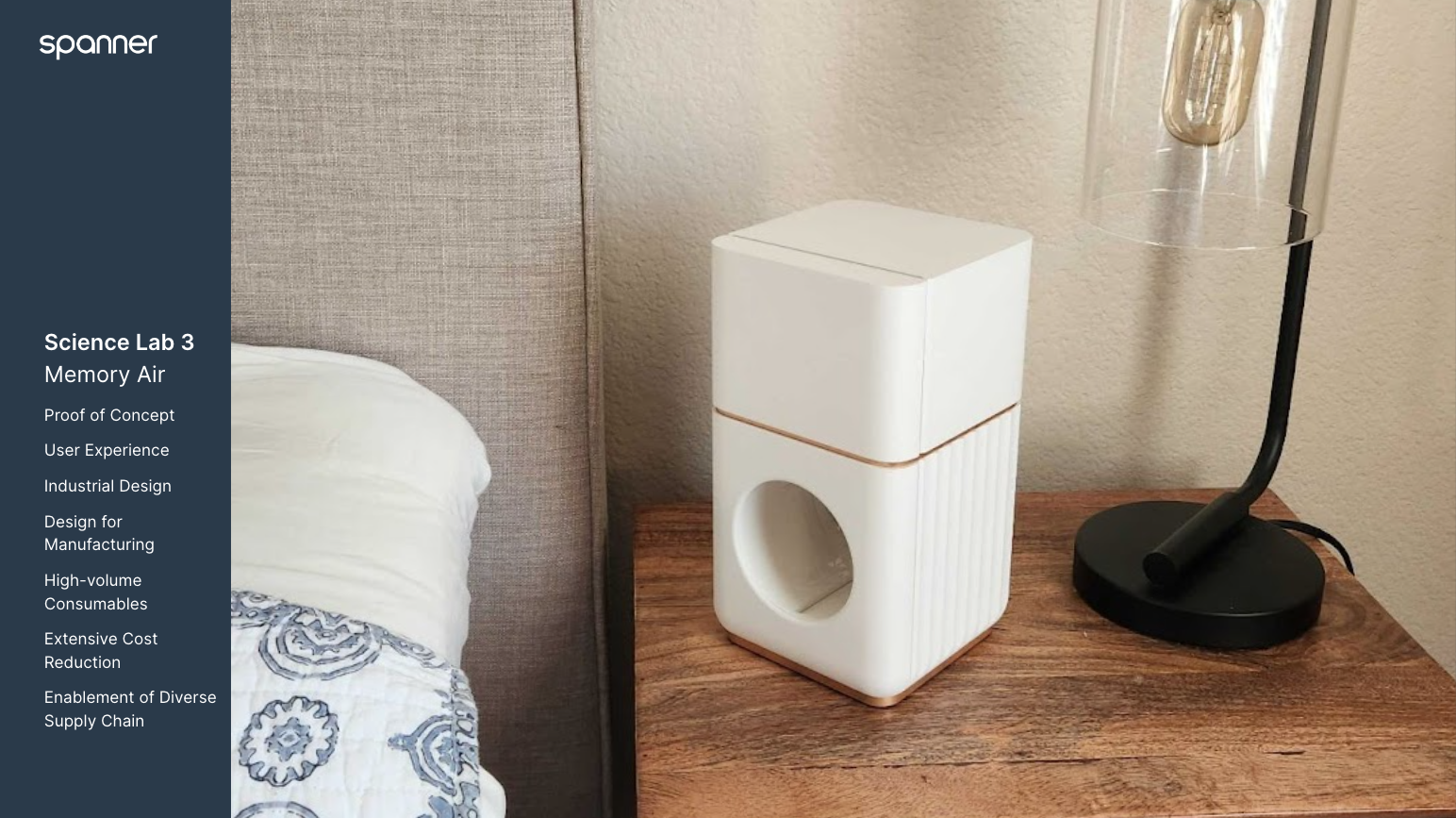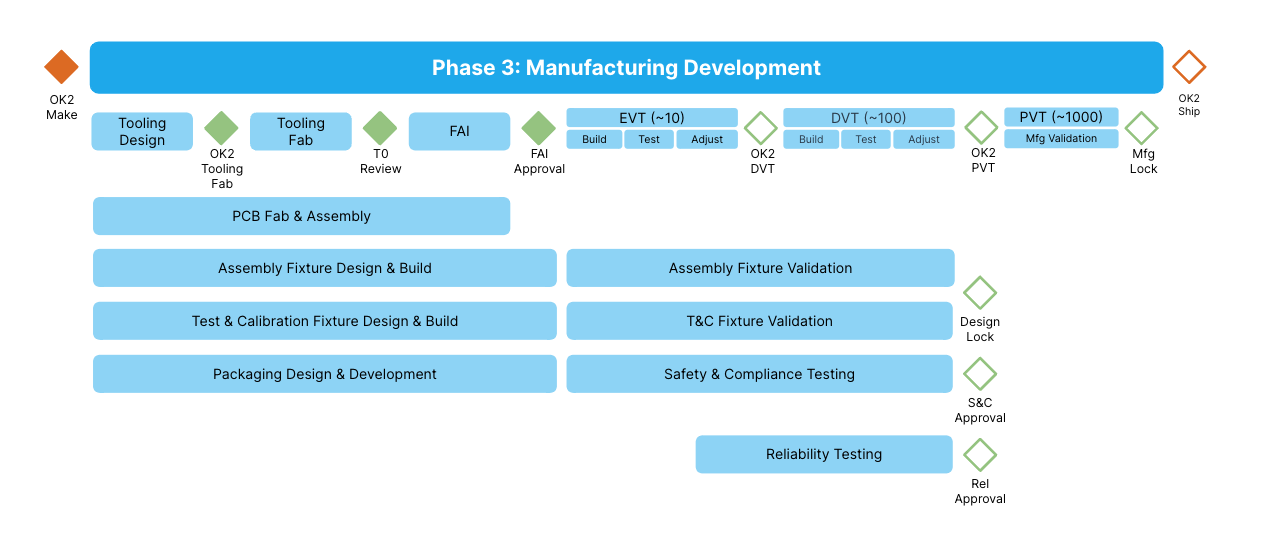Memory Air®
Sign up to learn more at learn.memoryair.com
Did you know that research suggests memory loss might not be inevitable? Groundbreaking studies show that smelling scents in sequence can stimulate the memory center, potentially slowing, stopping, or even reversing memory decline. This innovative therapy, driven by the connection between our olfactory nerves and memory, works even while you sleep.
Spanner's challenge was to create a user-friendly device for Science Lab 3 that could deliver a sequence of 40 unique scents silently and discreetly throughout the night. The user interface for Memory Air® needed to be incredibly simple, both for operating the device and reloading the monthly scent subscriptions. After all, for users concerned about memory issues, struggling with complex controls wouldn't be ideal.
Spanner is proud of the outcome and thrilled for Memory Air® to be recognized as one of TIME Magazine’s 2025 Best Inventions.
Phase 1: Building Consensus
The first phase focused on achieving a shared vision for the product. This involved creating a Product Requirements Document (PRD) that captured every detail clearly and comprehensively. Through productive discussions around each line item, we ensured the PRD considered all stakeholder concerns. To make informed decisions, engineers conducted crucial investigations, providing data that fueled collaborative discussions.
Meanwhile, designers began crafting the initial visual direction and user experience, while engineers established the core system architecture. This phase ensured everyone was aligned on the product's essence before diving deeper into development.
Symbiotic Design
As designers defined the form, scale, and proportion of the device, they maintained constant communication with their engineering colleagues to ensure a seamless integration of design with the mechanical and electrical layouts. The visuals you see here represent some of the later explorations in Phase 1, following convergence on this particular architecture.
Engineering Innovation
On the engineering side, Phase 1 involved crucial research and development. A key challenge was designing a system that could effectively deliver a sequence of 40 unique scents in a contact-free way in a nightstand-friendly size (think Kleenex box!).
We developed a novel scent carrier medium engineered to release the scent only under specific circumstances. Each scent resides in a dedicated pod on a rotating belt. As the belt advances, the device acts upon a single pod at a time, releasing that scent into a gentle stream of air.
For ultimate user convenience, the initial setup requires just one button press before bedtime to initiate the 24-hour scent cycle.
Phase 1: The Foundation for Success
By the end of Phase 1, the Product Requirements Document (PRD) captured every detail – features, functionalities, performance parameters, and even cost considerations, regulations, and shipping requirements – in a clear priority format (must-have, should-have, could-have). This comprehensive PRD streamlined technical details, emphasized user benefits, and served as the guiding light for everything that follows, from development to production.
The success of the finished product and the user experience hinged on the thoroughness of Phase 1 which laid the foundation for future phases’ success.
Phase 2: Refining the Design
Phase 2 was all about building and testing prototypes to progressively refine the design. Each prototype iteration increased in complexity and incorporates more details.
The first prototype (P0) focused on validating core functionalities – a "works-like" model to test the fundamental concepts behind the Minimum Viable Product (MVP). The MVP is a guiding principle, not a fixed product definition. It helped us prioritize features during this phase.
P1 built upon P0 by introducing a more realistic form factor and incorporating some design elements.
P2 added even more design details and integrated additional features. This stage often represents the first "looks-like, works-like" prototype, suitable for initial discussions with potential manufacturers about Design for Manufacturability (DFM).
Depending on the project, Phase 2 may encompass additional prototype cycles. Ideally, budget and time permitting, we recommend building 2-3 "Tool Release Prototypes." These prototypes closely resemble the final product, minimizing surprises during manufacturing and streamlining the testing process.
The final steps of Phase 2 involved finalizing tolerance analyses, integrating DFM considerations, and creating production drawings and material specifications.
Industrial Design in Action
During Phase 2, industrial designers worked hand-in-hand with the engineering team to refine every aspect of the product's look and feel. Prototypes 1 and 2 served as springboards for resolving design details, ensuring a seamless integration between form and function.
In this phase, a team may often create additional, targeted prototypes to validate specific user interactions with the device or explore various color, material, and finish (CMF) options. These explorations directly impact how users perceive and experience the product.
Through constant collaboration with engineers, designers meticulously considered details like lighting effects, surface textures, and button placement. This comprehensive integration of design elements was instrumental in conveying a sense of quality and user-friendliness to the final product.
Engineering Through Prototypes
Phase 2 was a period of intense collaboration for the engineering team. They began with rapid prototyping, using readily available materials to create P0 (first prototype). For Science Lab 3's device, the P0 featured a manually operated mechanism housed in a basic enclosure, with only the minimum functional details that would need to be carried forward in future prototypes. This quick and inexpensive approach allowed them to confirm performance expectations and refine parameters through testing.
With each prototype iteration, learnings were incorporated into the mechanical CAD design, including the PCBA Mechanical Control Outline (MCO). Throughout this process, mechanical and electrical engineers (ME and EE) worked in close collaboration, with initial firmware (FW) loading often coinciding with P1 or P2 builds. Just like on the design side, meticulous attention to detail during prototyping was crucial to ensure that the final product exudes quality.
Phase 3: Collaboration for Completion
Overcoming Challenges, Nearing Completion
Phase 3 marked the formal initiation of manufacturer engagement and the preparation and validation of production tools, processes, and facilities. Through a series of rigorous sequential phases, EVT (Engineering Validation Testing), DVT (Design Validation Testing), and PVT (Production Validation Testing), the phase’s key objective is achieved – to ensure production is ready for ramp at the anticipated volume rate, with all requisite tests and quality checks validated. Reliability testing plays a significant role here, uncovering potential failures that may require adjustments to parts using the final materials and manufacturing processes.
Anticipating and Mitigating Risks:
One of the biggest challenges in hardware manufacturing is supply chain management. To ensure a robust and reliable supply chain for Science Lab 3, we proactively sourced a second contract manufacturing partner to reduce risk and allow for a fast and seamless transition in the event of any unforeseen circumstances.
Building Strong Partnerships:
Throughout the development process, we maintained open communication with both the client and the chosen CM, ensuring everyone remained aligned. Additionally, we leveraged our partner network to introduce Science Lab 3 to a reliable 3PL (Third-Party Logistics) provider capable of handling all logistics, inventory management, and distribution.
Just like the earlier phases, the successful execution of Phase 3 hinged on close collaboration between industrial design (ID), mechanical engineering (ME), and electrical engineering (EE) teams. They worked together on tasks like evaluating initial production units (T1s), conducting hardware endurance testing, and ensuring alignment with the finalized color, material, and finish (CMF) specifications.
Phase 3 may occasionally involve support of marketing efforts through providing visuals for print and digital marketing collateral.
With patents pending for novel solutions to achieve objectives, we're excited to support the launch of Memory Air® and the introduction of a product with true human impact. We're so proud to enable the team’s vision to come to fruition and to be a part of their story. Learn more and sign up for updates at learn.memoryair.com
“Spanner has been a joy to work with. After two failed developments with other shops, Spanner was able to create our product in the way our chief scientist envisioned it. We’re excited about the future of memory care and it’s one step closer thanks to Spanner.”
Project Team
Memory Air®
Alan Bernstein
Hussain Rangwala
Michael Leon
Cindy Woo
Ricky Rohaidy
Spanner
Christian Garnett
Jorge Jordan
Marco Berkhout
Alex Kirkpatrick
Bethany Valderrama
David Bogdal
Lar Barham
“Developing Memory Air® has really been a dream project. We were able to start designing from the ground up and bring all the way to market a product that will make a positive impact on millions of lives. Moreover, this type of long-term client partnership has allowed us to build a level of trust and camaraderie that makes working with Alan and the Science Lab 3 team a real pleasure, week after week.”
More of Our Work













